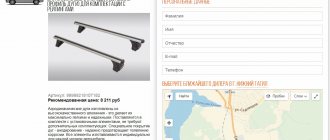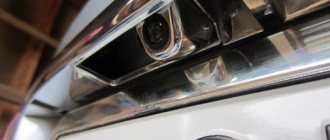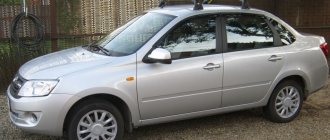The roof rack of a Priora car has two functions: for beauty and functionality - when you need to transport something from point A to point B. You can increase the carrying capacity using a roof rack on the car. The standard equipment of the Lada Priora in sedan, hatchback and station wagon does not include roof rails. You can install the trunk on the Priora yourself. Railings are different, the price is also different. Average price: 3,000 - 25,000 rubles.
Drivers looking to buy a practical, roomy car should consider purchasing a Lada Priora. VAZ takes into account the comments of customers and assembles cars with a spacious luggage compartment - if this is not enough: put an additional luggage rack on the roof. Read the article to the end and we will cover the topic of roof rails for you!
Technical characteristics of Lada Priora station wagon
The dimensions of the Priora station wagon, after restyling, have changed slightly due to new bumpers. So previously the length of the car was 4,330 mm, now it is 4,340 mm. It is also worth noting that the ground clearance of the Lada Priora station wagon is 5 mm greater than that of the sedan and hatchback and is equal to 170 mm. This difference is explained by the reinforced suspension, since the station wagon is designed not only for transporting passengers, but also for transporting all kinds of cargo. In particular, the car's rear springs have more coils. The height of the car is also greater when compared with its siblings. There is no big secret here, it’s just that all Lada Priora station wagons come standard with roof rails. See the detailed overall dimensions of the Priora station wagon below.
Dimensions, ground clearance, trunk Lada Priora station wagon
Vehicle powertrain
Three engine options are available:
- 8-valve VAZ-2116 engine with a power of 90 horsepower;
- 16-valve VAZ-21126 engine with a power of 98 horsepower. The station wagon modification with engine 21126 (factory designation VAZ 217130) is the most affordable on the secondary market;
- The 16-valve VAZ-21127 engine, which produces 106 horsepower, wins in terms of efficiency and reliability.
The base engine of the Lada Priora 2171 model is a gasoline, four-stroke, four-cylinder (cylinders are arranged in a row) 16-valve VAZ-21127 engine with distributed injection. This engine appeared after the VAZ-21126 engine was modified to improve the intake system. On the VAZ 21127, instead of one mass air flow sensor, two are installed: absolute pressure and air temperature. This made it possible to get rid of the known problem of the previous model - fluctuations in the crankshaft speed at low speeds.
The volume of this engine is 1596 cubic cm, the diameter of each of the four cylinders is 82 mm, the piston stroke is 75.6 mm, the compression ratio is 11. The octane number of gasoline used is 95. This engine develops power up to 106 horsepower at crankshaft rotation speed 5800 rpm, and its maximum torque is 148 Nm at 4200 rpm. It is obvious that the characteristics of the VAZ Priora with the 21127 engine are 8 horsepower and 3 Nm higher than those of a car of the same brand with the 21126 engine.
The dimensions of the restyled Lada Priora have not changed significantly. Although, due to the new front and rear bumpers, the length of the Lada Priora has changed by several millimeters.
As before, the restyled Lada Priora sedan has the longest length, which in the new version is 4,350 mm. The length of the station wagon is 1 centimeter shorter, but the Priora hatchback is even smaller, the length of this version of the body is 4210 mm. The width of the entire family is 1,680 mm and the wheelbase is the same for all 2,492 mm. But everyone’s height is different, the Lada Priora sedan is 1,420 mm, the hatchback is 1,435 mm, but the station wagon is generally 1,508 mm in height. The high height of the Priora station wagon is explained by the presence of roof rails. In a hatchback, the design of the rear part of the body is such that the car turns out to be taller than a sedan.
As for the ground clearance or ground clearance of the Lada Priora, the manufacturer indicates a figure of 165 mm for the sedan and hatchback, while the ground clearance for the Lada Priora station wagon is 170 mm. However, in fact, the ground clearance is greater; just pick up a tape measure and make sure of this. But the manufacturer is not mistaken; he simply indicates the vehicle’s ground clearance when fully loaded. At the same time, manufacturers of foreign cars are cunning and indicate the ground clearance of their cars in an unloaded state. therefore, the real ground clearance of foreign cars and their official data often do not coincide.
The luggage compartment volumes of the new version of Lada Priora in all three bodies have changed little. The sedan's trunk volume is 430 liters. The luggage compartment volume of the Priora hatchback is smaller, only 306 liters, but if you fold the rear seats (which cannot be done in a sedan), the volume increases to 705 liters. In the Priora station wagon, the luggage compartment volume is 444 liters, and with the seats folded down it reaches 777 liters. Unfortunately, the rear seats do not fold flat with the floor, and the large wheel arches eat up quite a lot of luggage space.
| Dimensions of Lada Priora | sedan | hatchback | station wagon |
| Length, mm | 4350 | 4210 | 4340 |
| Width | 1680 | 1680 | 1680 |
| Height | 1420 | 1435 | 1508 |
| Front wheel track | 1410 | 1410 | 1414 |
| Rear wheel track | 1380 | 1380 | 1380 |
| Wheelbase | 2492 | 2492 | 2492 |
| Trunk volume, l | 430 | 360 | 444 |
| Volume with seats folded | — | 705 | 777 |
| Fuel tank volume | 43 | 43 | 43 |
| Ground clearance, mm | 165 | 165 | 170 |
As for the tire size of the Lada Priora, the manufacturer recommends installing 14-inch wheels. The tire size can be 175/65 R14 or 185/60 R14 or 185/65 R14. The most interesting thing is that today, even on Lada Granta or Kalina in well-packaged trim levels, AvtoVAZ offers 15-inch wheels as standard. Why this is not the case on Priora is not clear, although this does not stop the owners of these cars, who put much larger wheels on their Lada Priora.
myautoblog.net
Features of the bodies of “Ladovo” models
ATTENTION! A completely simple way to reduce fuel consumption has been found! Don't believe me? An auto mechanic with 15 years of experience also didn’t believe it until he tried it. And now he saves 35,000 rubles a year on gasoline!
Since we started with QOL, let’s continue this topic. For the frame of Ladovsky models without glued glass, the quality of life is 14 thousand N*m/degree, which is a very good mark. And with glass this figure is even higher.
The testing of the Lada body in the rear turned out to be especially good. Thus, in the rear door opening, after a tough diagonal pressure test, the changes were recorded as only 1.5 mm, whereas on most foreign cars the same figure was 5-6 mm.
The body design of the Lada Largus and other similar models fundamentally complies with current European standards in terms of protecting passengers and the driver. The front subframe on Ladovsky models is one of the most important body elements responsible for this indicator. It is even considered an auxiliary spar, significantly increasing the strength of the body, as well as absorbing impact force.
The high quality of life of the Ladovsky body also has a beneficial effect on obtaining high-quality sound comfort in a car showroom. The frame does not twist over bumps and bumps, no deformations or anomalies occur between the interior and body elements, which ultimately has a positive effect on the absence of squeaks.
Note. Of course, in addition to the quality of life indicator, the quality of interior elements also affects the high level of sound comfort. They were obtained through proper calculation so as not to come into contact with the body in places where squeaking might occur. This was achieved by fixing the plastic components with special fasteners and minimizing the various gaps that arise one way or another between them and the body.
A lot of original parts, interchangeability of interior elements between Ladovsky models, enlargement of some parts of the body - all this was only a plus. In particular, the increase in some body elements led to a decrease in their number, which reduced production time and had a positive effect on performance.
Lada Largus
Called a budget station wagon with increased cross-country ability. The body was assembled based on Dasia/Renault Logan. The car was initially adapted for the market of Eastern European countries.
Even in the basic version of Logan, engineers took effective measures to enhance anti-corrosion protection, using protective inserts for the wheel arches. In addition, anti-corrosion and anti-gravity protection is installed over larger areas than before (at Samarov’s vehicles), with a thicker layer of mastic.
Here are some more innovations:
- The engine compartment is well protected. Additional protection was used correctly;
- The front suspension reinforcement has been increased. This was achieved through the use of leverage;
- The washer reservoir has become larger and holds more fluid;
- The wheels received protective aprons;
- The change got a torpedo;
- The bumper and radiator grille have been modernized.
It is noteworthy that the station wagon is made in 2 body versions: 5-seater and 7-seater. In addition, a van is also produced. The price of cars is low - only 350 thousand rubles and good comfort. When compared with foreign cars, the cost is heaven and earth.
In general, the Largus exterior is designed in such a way that it makes it possible to rightfully call the car roomy. A large family, along with bags and suitcases, as well as pets, fits comfortably inside. As for the design, the abundance of straight lines gives the car some speed and dynamism to the slightly clumsy family station wagon.
Height with rails is 167 cm, which is 10 cm more than Dasia Logan. The remaining sizes are also quite individual and do not copy “anyone”.
Lada Kalina
A car with 4 body types: sedan, regular 5-door hatchback, station wagon and sports hatchback.
"Sedan" version
Let's start with the sedan:
- From the new family of Kalina cars, AvtoVAZ is produced;
- The modern elegant appearance and comfortable interior are called the root reasons for the sedan's good sales;
- It has good handling at high speeds;
- It maneuvers well in the city traffic rhythm;
- Practical and incredibly convenient for daily use;
- The sedan body received wedge-shaped silhouette lines, visually creating the image of a strong, brutal car;
- The opening angle in the luggage compartment has been increased by 120 degrees, which makes loading easier. Inside the trunk, the manufacturer has wisely provided special loops that allow you to secure the cargo being transported.
The body as a whole is very durable, and its seat crossbar is subject to reinforcement. This rail saves passengers in the event of a side impact. In addition, the manufacturer provides special pads designed to protect the heads of the driver and passengers.
These are the body dimensions of the Lada Kalina sedan shown in the photo.
Station wagon version
The Kalina station wagon is, in fact, a full-fledged class B hatchback. AvtoVAZ is also produced. Sales of the model began in 2007, although orders were received based on individual requests long before that.
The versatility of this version is the main advantage of the hatchback over others. Sufficient maneuverability, despite its large size, and enviable dynamics for confident passage of city and country roads cannot leave the buyer indifferent.
The Kalina station wagon also has good cross-country ability. This makes the car popular among a wide range of car enthusiasts. So, with this station wagon you can safely go into nature, outside the city, even if there are very rough roads along the way.
As for the flat track, there is nothing to blame the car for here either. Handling is excellent, the car handles well, long trips are not tiring.
Kalina station wagon is practically unpretentious in terms of operating conditions and maintenance.
The salon is thought out to the smallest detail. Everything is done competently so that the driver and passengers feel comfortable. Five people can easily fit inside, and there is still room for luggage.
The cargo compartment is generally a separate matter. It holds all 380 liters of volume, and if you fold the back, the trunk can be transformed into a carrier.
The length of the station wagon body is 428 cm, the height without roof rails is 146 cm, and the width from one edge of the front wheels to the other is 168 cm. Now let’s compare it with a hatchback: the 1st indicator of the latter is 20 cm shorter, the 2nd indicator is 4 cm higher , and the 3rd indicator is 2 cm wider.
"Hatchback" Kalina
This full-fledged hatchback with 5 doors acts as a new version in the line of Kalinovsky modifications. The Kalina hatchback first appeared only in 2007, while Kalina has been produced since 1996. It is clear that drastic changes were made regarding the body, but the model also received other engines, more modern and meeting European toxicity standards.
The hatchback is ideal for passing city “traffic light” roads, as it is compact and equipped with an accurate power unit with ESVT. This ensures not only high speed characteristics, but also affects minimal fuel consumption.
The short body length (only 408 cm) helps the hatchback not only successfully maneuver among traffic, but also affects overall safety.
“Korotysh” can be called the most purchased “Kalinovskaya” model today, and this is not only a matter of novelty. Russian motorists have always liked hatchbacks, and this one is also equipped with the latest peak of auto fashion: a single key for locks, remote control. control, PU alarm and much more.
Lada Granta
The most popular version of the Grant today is the sedan. The liftback has also become a good seller, but it is still far from being a sedan. The VAZ 2190 is designed for 4 passengers, according to the documents it looks like a B-class car, but after considering the dimensions, you can safely classify it as a C-class.
Being a successor of the “Kalina” traditions, the sedan was even assembled on its platform and borrowed a lot of things from Kalina: body, chassis, interior. On the other hand, it is a different car with a different character, larger cargo compartment, redesigned design, etc. The trunk has been increased to 500 liters.
Here are the standard body dimensions of the Lada Grant.
As you can see, the dimensions of this VAZ model are 22 cm longer than those of the Kalina, but 7 cm shorter than the “Samarov” modifications.
Now other characteristics in more detail:
- The radiator grille has received a new corporate style, now resembling a Volga rook, which is held in place by a powerful molding. This grille cools the engine compartment more effectively, as it is equipped with large “nostrils”;
- The bumper is much softer than the VAZ ones and is painted in body color on some car trim levels;
- The general lines of the hood and trunk roof are slightly raised;
- The front optics have received more enlarged outlines, and in the basic version the cars are also equipped with daytime side light.
As for the trim levels, the new sedan can be purchased in 3 versions. The coolest is the Lux, equipped with a 98-horsepower engine and featuring a completely different level of interior equipment.
Among the features of the Granta body, one can highlight the good quality of the assembly and good quality of materials. The body parts are connected to each other using high-tech automated German welding. This allowed domestic producers to reach a completely different level.
We also highlight the good quality of painting and resistance to anti-corrosion treatment. Both of these processes are also carried out on German-made automated lines with excellent precision.
The modified body geometry gave the new Russian car a stylish, aspirational lines. This had a beneficial effect not only on the exterior, but also made it possible to significantly reduce the AED resistance. Now this coefficient is 0.36, which is more than 6 percent less than the base model. In addition, the pointed hood is less harmful to pedestrians, experts say.
Important functions are performed by overhangs:
- The Granta's rear overhang has been extended by 15 cm. In turn, this makes the interior even more spacious than before;
- The front overhang is designed in such a way as to reduce the thermal load on the engine and its environment.
As for other body differences:
- The underbody was specially designed for the new Russian car. Special metal sheets with special hardening and double-sided galvanization are a good solution that significantly increases service life;
- As for quality of life, in this particular case the indicator is increased by 12 percent when compared with Kalina;
- The weight of the car was reduced by as much as 40 kg, which could not but affect the handling. Now it has become much easier to maneuver in city tight rows, it is more convenient to take turns;
- It has become easier to install an additional roof rack, since the manufacturer has provided good, strong fastenings on top of the door seals.
Unfortunately, Granta did not lose the traditional VAZ “sores”:
- It is inconvenient to adjust the side mirrors. But this is not necessary, since they provide quite good visibility;
- On the other hand, short drivers will have poor visibility of the road due to the raised lines of the hood and trunk.
Lada Priora
Another VAZ model – Priora – is presented in 4 body versions. Let's look at the body features of each version separately.
"Sedanovskaya" Priora
It is an improved “ten”. The model is distinguished by an elegant, expressive design, good AED quality, and a pleasant interior.
As is typical for sedans, the Priora’s design has better adherence to geometry. This gives the exterior a stylish look.
Here are some more differences:
- The optics are elegantly designed, both front and rear;
- The radiator panel with an elegantly carved large brand name looks very aesthetically pleasing;
- The shape of the wheel arches, made in an open style, deserves approval.
Here are the standard sedan sizes.
Priora hatchback
The second model in the Lada Priora family. The ideal embodiment of the best 5-door hatchback ever assembled at AvtoVAZ.
The new hatchback has received a lot of innovative solutions regarding appearance and technical capabilities.
The 2172 body was designed using the popular PC geometric modeling method. Thanks to this, it was possible to achieve high precision, and it, in turn, had a beneficial effect on the mating of body parts, eliminating large gaps and differences in surfaces.
Priora station wagon
The final model of the Priora family. The body is assembled on the basis of a sedan. Moreover, this version is carefully designed by modernizing the design features of the eleventh VAZ model. Thus, this sample received all the advantages of previous versions, losing their weak points.
The Priora station wagon receives about 200 original body elements. Bumpers of a completely different tempering, fenders of an original and unusual shape, a stylish roof - all this is new for the Russian motorist. The trunk, if transformed, can accommodate 777 liters of cargo.
External and internal features
Lada Priora, released in 2012, is distinguished by improved body assembly quality, including the introduction of new standards into car production technology that relate to the assembly of side doors. This model is also equipped with an updated front bumper, a new radiator trim and exterior mirrors. Thus, the Priora station wagon is a more stylish and energetic VAZ model.
As for the overall dimensions of this car, it is 4340 mm long, 1680 mm wide, 1508 mm high, with a 2492 mm wheelbase and 165 mm ground clearance. The factory equipment includes the installation of tires with rims 175/65 R14 - 185/65 R14. Trunk parts and other car body parts are made mainly of low-alloy and galvanized steel.
Spacious and comfortable interior
As for the internal features, the 2012 Priora station wagon is equipped with rear seats with the ability to transform them. Legroom is limited, but headroom is spacious. The cargo capacity of the trunk allows you to place a lot of things in it. When traveling with five passengers, it holds 444 liters. If you fold the second row seats, then the trunk capacity is 777 liters. Taking into account the experiment, it can be noted that the maximum loading of the Priora station wagon trunk is 1200 usable liters. If we consider the carrying capacity, then it accounts for 505 kg.
Thus, one of the advantages of a car with an automatic or manual transmission is the trunk. The downsides are the uncomfortable front seats, poor-quality interior assembly and materials used for this.
First vibration-isolating layer
Following the standard trunk noise insulation scheme, the first layer means covering the surface inside the trunk with vibration material. The highest quality vibration-absorbing materials are considered to be materials from STP and Shumoff.
First, you need to cut several sheets of a certain size and shape from a single sheet of vibration-isolating material, and then slightly warm up the bitumen side using a technical hair dryer.
Then the heated sheets of vibromaterial are carefully laid on the cleaned and degreased trunk frame and carefully rolled out with a hard roller made of iron or plastic.
After the first sheets fill most of the trunk area, the next sheets of vibration material should be prepared in the same way. They must be overlapped.
As a result of the manipulations performed, the metal surface of the body should be covered by 55-100%, depending on the material used.
Geometric dimensions
If the so-called overall dimensions of the body were presented above, now we will talk about geometric ones. Knowing these dimensions will not only allow you to form an opinion about the car or help you choose, but will also make it possible to carry out professional repairs.
Video on how to take geometric dimensions of a body
The set of distances between certain points of the body, called control points, is called geometry. They are initially installed by the manufacturer at the factory. It is clear that these points provide an ideal, precise position.
To check the compliance of the geometric dimensions of Lada cars, the owner must measure certain distances shown in the photo below.
It also wouldn't hurt to measure these dimensions.
For those who are interested in purchasing a Lada Priora station wagon, the technical characteristics of the body, engine and suspension are equally important. “Lada Priora” is the direct heir and successor of the flagship family of VAZ 2110 models of the Volzhsky Automobile Plant. Several hundred changes were made to the design of the car, so the VAZ-2170, VAZ-2171 and VAZ-2172 models (sedan, station wagon and hatchback, respectively) are considered to be a separate family. The first sedans went on sale in 2007, and station wagons in 2009. The Lada Priora station wagon is the most practical and spacious car in the family. At the end of 2015, AvtoVAZ stopped producing and accepting orders for this model.
Lada Vesta: trunk description
Let's start the review with the sedan currently being produced. The trunk volume of the Lada Vesta sedan is neither more nor less – 480 liters. In such a trunk you can place almost any household appliances, garden supplies or installation tools - the dimensional characteristics of the loading area allow this to be done without much difficulty. If for some reason you need more space, you can fold down the seat backs.
As for other body types, only approximate parameters are known at the moment. Surely you are most interested in the Lada Vesta Station Wagon model. The trunk volume in liters will not differ much from sedans and will be about 500 liters. The luggage compartment capacity of the hatchback body is currently unknown, and one can only assume that it will be noticeably reduced compared to the sedan.
Life hack: Priora roof rack - types, installation
The roof rack of a Priora car has two functions: for beauty and functionality - when you need to transport something from point A to point B. You can increase the carrying capacity using a roof rack on the car. The standard equipment of the Lada Priora in sedan, hatchback and station wagon does not include roof rails. You can install the trunk on the Priora yourself. Railings are different, the price is also different. Average price: 3,000 - 25,000 rubles.
Drivers looking to buy a practical, roomy car should consider purchasing a Lada Priora. VAZ takes into account the comments of customers and assembles cars with a spacious luggage compartment - if this is not enough: put an additional luggage rack on the roof. Read the article to the end and we will cover the topic of roof rails for you!
Station wagons LADA Kalina, Priora
Having loaded the “installer’s kit” into the Priora, we discovered that there was still room for several more boxes.
Having loaded the “installer’s kit” into the Priora, we discovered that there was still room for several more boxes. “Priora” is somewhat similar to its rival. The same “empty” steering wheel (its rotation is accompanied by a quiet but annoying buzzing of the electric booster), quite decent smoothness. But the dynamics are much better, even with the air conditioning on. It is clear that with it the car accelerates not as quickly as with it not working, but there is no need to be ashamed. And if you remember that, according to the passport data, the fuel consumption of both station wagons is almost the same, then the conclusion which one wins suggests itself. However…
see also
Comments 18
Please tell me, were the stops sold in pairs or just one?
Thank you. I ordered it according to your article number and it came alone
Place them correctly, turn them the other way around, it will slow down and work as intended by the manufacturer. By mistake, last year I installed the stops incorrectly, this year I threw them out due to a fucking grinding noise on bumps and when opening the lid. I won't repeat these mistakes again.
What is their price? I’m also thinking about changing the stops... otherwise one day the cover flew to me =D
I took it for 1200r. But you can find it cheaper.
In terms of trunk volume, the sedan is located between a hatchback and a station wagon.
Let us remind you that this family is presented on the market in three different bodies:
- sedan;
- hatchback;
- station wagon
Now let's look at the numbers. According to the manufacturer, the trunk of a Priora with a sedan body can be placed between a hatchback and a station wagon in terms of volume. Its volume is 430 liters. This is a very good indicator for cars of this class.
The hatchback's trunk is the least spacious. Its volume, according to the manufacturer, is inferior to the sedan and is only 306 liters. However, there are two very important points here. Firstly, the large rear door allows you to load much more cargo into the car than can be placed in the trunk of a sedan.
In addition, with the rear seats folded down, the luggage space of the Priora with a hatchback body increases to a very respectable 705 liters. Agree, it is quite possible to place here, for example, a washing machine, which, even if you wanted to, cannot be stuffed into a sedan. The rear seat folds down quite simply, but the designers have not been able to come up with a solution that allows it to be laid flush with the floor. In addition, the wheel arches take up some luggage space. Nevertheless, the numbers, compared to other classmates, are quite decent.
Well, the most spacious in the Priora family is, of course, the station wagon model. The trunk volume here is 444 liters. Naturally, the rear seats can also be folded down. In this case, the volume of the luggage compartment increases to 777 liters. Add here a large rear door - and you will get the most optimal option for transporting various cargo, including quite large ones, among all Priora cars.
As you can see, the sedan, all other things being equal, is practically not inferior to the station wagon in terms of trunk volume in liters. At the same time, it is also significantly ahead of the hatchback. But as soon as you fold down the rear seats, the picture completely changes. The station wagon continues to confidently hold the lead, while the hatchback is already ahead of the sedan.
When choosing a Priora, this point is also worth taking into account. If you are not going to often transport bulky cargo, then a sedan is quite suitable for you.
If you plan on relatively regular transportation, for example, delivery of goods to shops, then you should pay attention to a more spacious station wagon. Cars of the Priora family have proven themselves to be a very good option for their price
They have good dynamics, while being quite economical, hold the road confidently, and the ride here is more comfortable than on the VAZ “tenth” series.
Causes of wiper malfunction on Priora
Don’t also forget that the Priora was restyled in 2013. The designers added a number of new options to all cars in the family, further increasing their competitiveness in the automotive market. In particular, the updated Priors received more modern optics controlled by a light sensor. Many people liked the slightly changed bumper, and the LEDs built into the lights and foglights made the car less “gluttonous” in terms of electricity consumption.
The interior of the car has also undergone changes for the better. The designers included finishing materials in the restyled version that cannot be called typical for VAZ products. In particular, soft-look was used here - a type of plastic that looks very much like expensive leather.
In addition to its excellent aesthetics, the undoubted advantage of this material is also its fairly high resistance to various types of influences. Also, owners of the restyled version will be pleased with the new shape of the steering wheel, a beautiful instrument panel and a touch screen. Well, thanks to higher seats with armrests, the designers were able to increase the level of comfort for both driver and passenger.
Helpful information
Why do you need a false panel in the trunk, where to install it
Additional shelves in the trunk most often house external amplifiers, capacitors, and processors that do not fit inside the car. Many car enthusiasts do not want to clutter the space near the front passenger’s knees with hanging structures. There is enough space in the trunk of a car to freely place additional equipment, but it must be properly positioned and protected from damage when the compartment is loaded with luggage.
In the trunk of a sedan, from the locations of the mounting shelves and the false panels covering them, the side openings near the wheel arches and the recessed space under the rear window are convenient. Less commonly, a raised false floor is installed in the trunk, which can be considered a type of false panel. In the trunks of two-volume hatchbacks and station wagons that are not equipped with a partition between the passenger compartment and the luggage compartment, broadband woofers, additional midbass, and compact low-power active subwoofers can be placed on mounting shelves.
Speakers directed by diffusers into the cabin, supply cables and connectors on mounting shelves become vulnerable to mechanical damage. The trunk looks unsightly when the fifth door is open
When loading things, you must be careful not to damage the equipment. Therefore, the installation of false panel panels has two purposes: to protect the equipment and maintain the attractive appearance of the luggage compartment
Fans of acoustic tuning are less concerned about reducing the physical volume of the trunk; fans of acoustics occupy the entire luggage compartment with large subwoofers.
The placement location depends on the number and dimensions of the acoustic equipment. The false panel can be used to cover mounting shelves raised to the level of the top of the backrests of the rear passenger seats (in hatchbacks, station wagons, crossovers). To protect amplifiers and capacitors, there are false panels covering the wings of the luggage compartments. In sedans, transverse vertical trim panels are most often installed at the level of the inner cut of the trunk lid.
Raised floor panels (raised floors) are less suitable for placing acoustic equipment. The main danger of such an arrangement when the trunk is loaded with acoustics is considered to be overheating of operating acoustic devices in a closed, unventilated space.
Materials and tools for manufacturing
Any durable and lightweight materials are suitable for making the base of the false panel. Thin, rattling household and construction plastics, thin metal sheets, fiberboard sheets, and chipboards are not suitable for decorative partitions. Durable plastics (fiberglass vinyl plastic, textolite, plexiglass) are expensive and not everyone has access to them. The same can be said about natural wood - thin boards of oak or beech.











